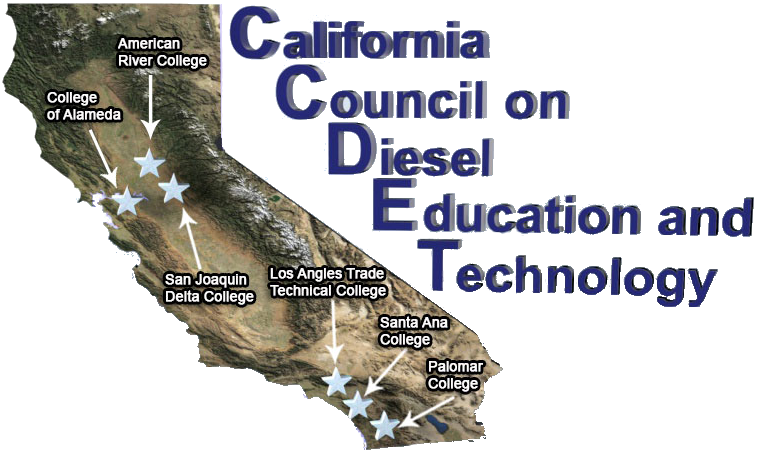California Council on Diesel Education and Technology
Background Info
HDVIP Background
Emissions from heavy-duty diesel vehicles are a major contributor to the total California inventory of particulate matter. Particulate matter is generally classified as PM-10 for particles with diameters of 10 microns or less, or PM-2.5 for particles with diameters of 2.5 microns or less. Studies show that diesel exhaust primarily consists of PM-2.5.
These emissions post significant environmental and public health impacts.
Losses in agricultural productivity from total environmental impacts are estimated by the ARB at $300 million plus per year. Public health impacts associated with diesel emissions include an increase in various respiratory diseases and cancer. Additionally, excessive smoke emitted from heavy-duty vehicles continues to be the public’s primary air pollution complaint.
In response to these concerns, California Senate Bill (SB) 1997 (Pressley) was enacted in 1988 authorizing the ARB to implement a roadside smoke enforcement program designed to curtail the excessive smoke emissions resulting from mal-maintained and tampered heavy-duty vehicles. Following a detailed field study, the ARB implemented the Heavy-Duty Vehicle Inspection Program (HDVIP) in 1991. Additionally, a companion Periodic Smoke Inspection Program (PSIP) requiring California fleet owners to self-inspect their fleets for excessive smoke emissions was developed in 1993 in accordance with California SB 2330 (Killea).
Diesel Risk Reduction Plan
In 1998 the ARB identified particulate matter from diesel-fueled engines as a toxic air contaminant (TAC). Particulate matter emissions from diesel-fueled vehicles and engines are about 28,000 tons per year in California.
AB 584
In 1993, AB 584 was enacted to address the concerns of the trucking industry regarding smoke emissions testing.
These emissions come from a wide variety of sources including over one million on-road and off-road vehicles, about 16,000 stationary engines, and close to 50,000 portable engines. On-road engines account for about 27 percent of the emissions, off-road engines about 66 percent, with the remaining 7 percent from stationary and portable engines. With full implementation of the current vehicle standards on the books and vehicle turnover, diesel particulate matter (diesel PM) will still be about 22,000 tons per year in 2010 and about 19,000 tons per year in 2020. On a statewide basis, the average potential cancer risk associated with these emissions is over 500 potential cases per million. Diesel PM emissions are estimated to be responsible for about 70 percent of the total ambient air toxics risk. The ARB staff proposed the Diesel Risk Reduction Plan which requires all new diesel-fueled vehicles and engines to use state-of-the-art catalyzed diesel particulate filters (DPFs) and very low-sulfur diesel fuel. Further, all existing vehicles and engines should be evaluated, and wherever technically feasible and cost-effective, retrofitted with DPFs. As with new engines, very low-sulfur diesel fuel should be used by retrofitted vehicles and engines. In short, the plan contained the following three components:
- New regulatory standards for all new on-road, off-road, and stationary diesel-fueled engines and vehicles to reduce diesel PM emissions by about 90 percent overall from current levels
- New retrofit requirements for existing on-road, off-road, and stationarydiesel-fueled engines and vehicles were determined to be technically feasible and cost-effective
- New Phase 2 diesel fuel regulations to reduce the sulfur content levels ofdiesel fuel to no more than 15 ppm to provide the quality of diesel fuel needed by the advanced diesel PM emission controls.
The projected emission benefits associated with the full implementation of thisplan, including proposed federal measures, are reductions in diesel PM emissions and associated cancer risks of 75 percent by the end of 2010 and 85 percent by the end of 2020. The measures recommended in this plan will have a great impact on reducing the localized risks associated with activities that expose nearby individuals to diesel PM emissions. Further, there are other benefits associated with reducing diesel PM emissions.
Excessive Smoke
Excessive smoke emitted from heavy-duty vehicles continues to be the public’s primary air pollution complaint.
These include reduced ambient fine particulate matter levels, increased visibility, less material damage due to soiling of surfaces, and reduced incidences of non cancer health effects, such as bronchitis and asthma. Staff expected that the costs associated with carrying out this plan would be significant and would be on the order of the costs associated with other major ARB programs.
Currently, regulations have been implemented and are being enforced, that will reduce emissions from diesel engines. To learn more about the Diesel Risk Reduction Plan, please see: http://www.arb.ca.gov/diesel/background.htm.
Although the HDVIP has been effective in reducing the number of excessively-smoking heavy-duty vehicles, its smoke test procedure (SAE J1667) was the focus of controversy.
The trucking industry argued that the HDVIP’s snap-acceleration test was unreliable and incorrectly failed clean trucks. This contention began during the program’s inception in 1991, and was litigated four times. In all cases, the test was upheld by the California courts, including two decisions by the Third District Court of Appeals that were left standing by the California Supreme Court. The trucking industry now fully supports the snap-acceleration test with the adoption of the SAE J1667 test procedure.
The HDVIP was suspended by the ARB in October 1993 to redirect staff to investigate reformulated diesel fuel performance issues and subsequent clean fuels program assignments. Around this time, Assembly Bill (AB) 584 (Cortese) was enacted to address the trucking industry’s concerns, and requires that the test procedure used in the HDVIP produce consistent and repeatable results, and that this requirement may be satisfied by the adoption of a roadside smoke test procedure developed by Society of Automotive Engineers (SAE J1667). The legislation further requires that the test produce no false failures or have a process to remedy any false failures.
This page last reviewed .
